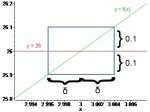samistumbo
New member
- Joined
- Aug 17, 2011
- Messages
- 23
I am doing alright with all the material from this current Calculus chapter, but I am having a very hard time with these two problems (oictures are attached, but I couldn't figure out how to make them bigger in the preview):
#1
For the limit lim (x→3) (x^3-2x+5)=26
illustrate the definition by finding the largest possible values of δ that correspond to ε = 0.2 and ε = 0.1.
ε = 0.2 δ= ?
ε = 0.1 δ= ?
The definition they're referring to is, lim (x→a) f(x)= L if for every number ε > 0 there is a number δ> 0 such that
if 0<|x-a|< δ then |f(x)-L|<ε.
#2
Given that lim (x→4) (4x-6)=10, illustrate Definition 2 by finding values of δ that correspont to ε=0.5, ε=0.1, ε=0.05.
ε=0.5 δ ≤ ?
ε=0.1 δ ≤ ?
ε=0.05 δ ≤ ?
#1
For the limit lim (x→3) (x^3-2x+5)=26
illustrate the definition by finding the largest possible values of δ that correspond to ε = 0.2 and ε = 0.1.
ε = 0.2 δ= ?
ε = 0.1 δ= ?
The definition they're referring to is, lim (x→a) f(x)= L if for every number ε > 0 there is a number δ> 0 such that
if 0<|x-a|< δ then |f(x)-L|<ε.
#2
Given that lim (x→4) (4x-6)=10, illustrate Definition 2 by finding values of δ that correspont to ε=0.5, ε=0.1, ε=0.05.
ε=0.5 δ ≤ ?
ε=0.1 δ ≤ ?
ε=0.05 δ ≤ ?

